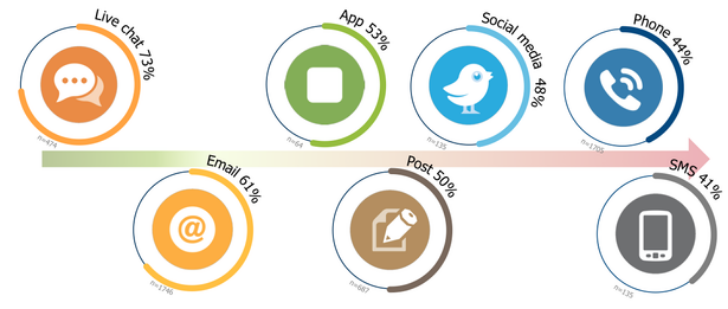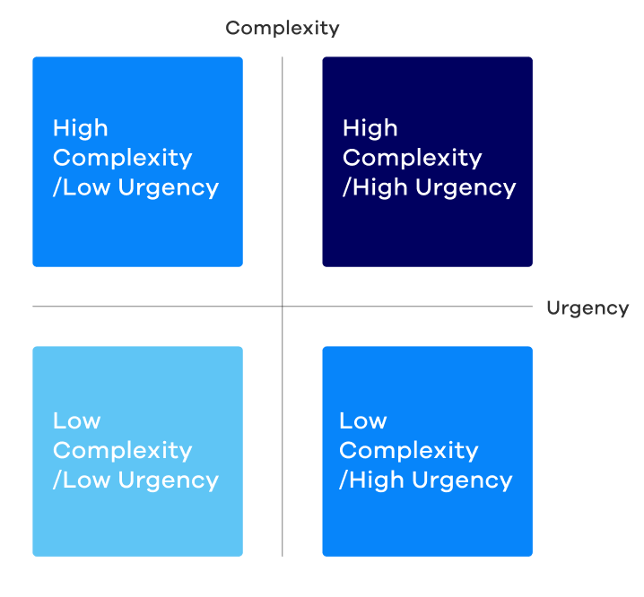Stay updated!
The best customer experience content delivered right to your inbox.
Why Growing Support Teams Should Focus on One Channel Not Many
by UJET Team |
Great omnichannel support requires the right tools and training to ensure that your team provides a consistent customer experience. As your company grows, you’ll need to support a higher volume of customers—which means scaling your customer-support team to meet their needs.
Customers want to be able to contact you via email, phone, live chat or social media, and they expect the same experience with every channel. It’s important to meet customers where they want, but you can’t just start offering omnichannel support all at once—overextending your support team will cause issues.
When you’re scaling customer support, the goal should be providing a consistent experience across every new channel. That’s only possible with the right tools and training.
That’s why it’s important to think about which channels are best suited to your customers as well as your team. Knowing where to start can help your team expand faster without doing any damage to the customer experience.
Figure out which channels your customers want to use
Expanding into a new support channel makes sense only if your customers will use it. As you’re scaling customer support for your company, reach out and survey customers to find out about their preferences. That information will give you a way to plan your expansion in a way that provides the most value up front.
A good customer feedback survey will also help you understand what customers expect from each channel. The first step toward providing an exceptional customer experience is making sure you know what your customers want.

Customer service channel preference via eConsultancy.
For some companies, it makes sense to start by offering phone support; others would benefit from live chat.
Let’s say your company offers support via email, but recently there has been an increase in engagement with your company’s Twitter account. Customers use social media to seek immediate answers to urgent questions. While it might seem like implementing a social media support strategy is needed, you could help solve the customer’s problems another way. Live chat makes your team just as accessible and is equally good for urgent issues.
Send out a survey to poll customers to figure out what they really want. It also gives you an opportunity to let them know that you care about their opinions and are open to feedback.
If you plan to add a new support channel you need to make sure it’s one that benefits your customers. This allows your team to make connections with the customer in the channel of their choice.
Find tools that support the right channels
Being able to support customers effectively, without struggling to work with difficult tools, lets your agents focus on providing the best possible customer experience at all times. Once you know what channels your customers want to use, you can start deciding which contact center platform is the best fit.
As you’re considering different tools to support a new support channel, it’s also important to understand how customers interact with the team. Customers’ current experiences will inform how they think about receiving support in the future.
When an issue is complex but doesn’t need to be resolved immediately, the customer can always reach out via email. If it’s a simple issue that needs to be fixed right away, they’ll likely use live chat when available.
The complexity and urgency of an issue will dictate which channel the customer uses.

Knowing what kinds of issues customers typically have when reaching out helps your team direct them to the right channel.
Using our earlier example, customers on social media are probably looking for immediate answers from your team. Their urgency is what informed the use of social media instead of another channel.
The problem with social media is that it doesn’t work well for complex issues. Expanding your support into that channel makes sense only for a small portion of customer interactions your team has.
That is why it’s important to understand how any new software supports the channels you want to use. If a tool only supports a single channel, you need to understand how it integrates with other workflows. Omnichannel platforms can be more efficient for both your customers and your team. When you streamline the experience, it helps keep the customer experience as simple and straightforward as possible.
Make sure your team is comfortable providing support in every channel
Expanding into a new support channel will require training to ensure that the customer experience doesn’t suffer. Current team members will need to integrate this new channel into existing workflows as well as help the new agents, who will join the growing team, along the way. Good training programs help onboard new hires and maintain a consistent experience.
Giving your current team a way to test the new channel during training lets them provide valuable feedback as well.
Keep in mind that not every agent will excel in every channel. Providing live chat support takes a skill set different from that for phone or email support. These training programs can help find the right team to staff different channels more effectively.

Ongoing training ensures that the experience is equal across every channel. If some agents are more skilled with phone and email support while others prefer live chat or social media, you can have them to help train other team members.
Being comfortable switching between channels will help provide a better experience and give everyone involved a better sense of how best to support the customer.
Great omnichannel support requires thoughtful growth
Scaling customer support with your growing company is a marathon, not a sprint. You need to understand how to expand into each new channel in a way that maintains a consistently exceptional customer experience.
It’s important to find the right channels, make sure your tools support them efficiently and ensure that your team is trained to feel comfortable across the board. Every new support channel you use can add or detract from the customers; when you’re thoughtful about how to approach this growth, it makes it easier for your team and more effective for the customer.
The best customer experience content delivered right to your inbox.